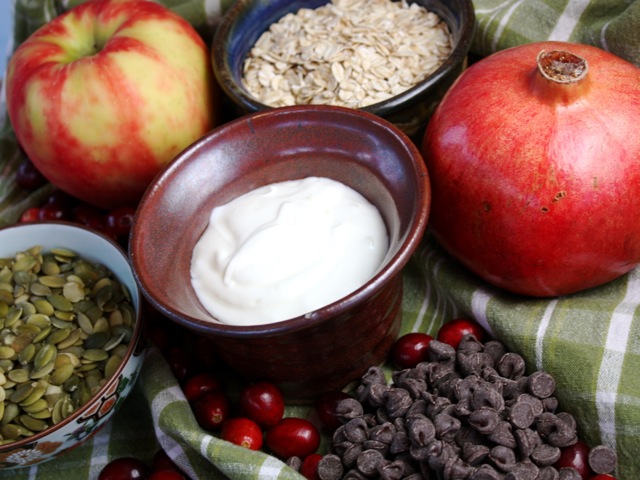
reference-image, l
(article, Linda Shiue)
[%pageBreakSettings nobreak=true] As the food writer Mark Bittman recently noted, winter has traditionally been a season of deprivation, not of overindulging. [[block(sidebar). h1.Featured recipes]] But what with Thanksgiving, Christmas, and all of the other festivals crowding the cold-weather schedule, these supposedly lean times aren't exactly slimming. Pumpkin pie, Christmas cookies, egg nog . . . you know the list. American adults gain about a pound a year, and most of that weight gain happens over the end-of-year holidays. Getting off the gravy train can be difficult — and restrictive diets can lead to binge eating. Which is why I don't recommend going cold turkey on seasonal treats. Instead, I counsel caution — and some good switcheroos. That way, you don’t need to keep those visions of sugarplums just dancing in your head. [%image reference-image float='clear right' width=400 caption="Healthy, seasonal dessert ingredients include (clockwise from top left) apples, oats, pomegranates, dark chocolate, cranberries, yogurt, and pumpkin seeds."] First off, a short checklist of baking tips. # Line baking pans with parchment paper, even if the recipe doesn't call for it. You'll use less butter for greasing the pans (which means fewer total calories), and your cakes will slide out of the pans more easily (which means fewer kitchen tragedies). # Applesauce makes a great oil (but not butter) replacer in baked goods like gingerbread. It adds a serving of fruit, reduces calories, adds fiber, and can pack in a lot of moisture, giving your baked goods a longer shelf life. # Substitute white whole-wheat flour for at least half of the flour called for in a recipe. This will add fiber, B vitamins, and iron without the heaviness of standard whole-wheat flour. # Nuts and seeds add crunch and flavor, and they boost nutrition with fiber and vitamins. If you don't feel like adding them to a batter, scatter them atop cakes and cookies. Secondly, here are eight tips for indulging in sweets without slipping overboard. [[list(culinate8). #(clear n1). Eat fruit. Find a perfect piece of seasonal fruit and savor it. Citrus and persimmons are special treats this time of year. #(clear n2). Eat a flip. Fruit alone not cutting it? Do the "dessert flip" — instead of a large dessert with a little fruit garnish, have a lot of fruit with a small piece of very good chocolate, a little cookie, or a tiny piece of cake. #(clear n3). Eat moderately. Enjoy whatever dessert you like — occasionally and in reasonable portions. #(clear n4). Eat small. Having trouble with portion sizes? Use small plates and bowls. Sure, it sounds like a silly mind trick — but it works. #(clear n5). Eat mindfully. You’ll get more enjoyment out of a few small bites eaten slowly than a whole portion eaten quickly. And think twice before reaching for a second serving; it can take a while for your brain to realize that your stomach is full. #(clear n6). Eat spices. All the spices that we associate with winter-holiday baking — allspice, cardamom, cinnamon, cloves, ginger, mace, nutmeg — add a sensation of sweetness without sugar. Plus, they're complex in flavor, making them more satisfying for many eaters than, say, plain sugar cookies. #(clear n7). Eat contrasts. Entertain yourself by using contrasts in texture, color, and flavor. In my recipe for Dark Chocolate Vanilla Pomegranate Parfait, the crunchy and sweet (and bright red) pomegranate seeds contrast with the deep darkness and airy lightness of the chocolate mousse and the rich, tangy, pale creaminess of the Greek yogurt. #(clear n8). Eat not just for yourself. If you're celebrating in a restaurant, consider sharing a single dessert with your tablemate. If you’re making dessert, bring it to a party, share it with your neighbors, or freeze some for another time — perhaps a cold, gray day late in January, to bring back a little of that holiday cheer. ]] p(bio). Dr. Linda Shiue is an internal-medicine physician at the Palo Alto Medical Foundation in the San Francisco Bay Area. She teaches healthy-cooking classes to patients and community groups and writes about food on her blog, Spicebox Travels. Follow her on Twitter: @spiceboxtravels.

reference-image, l